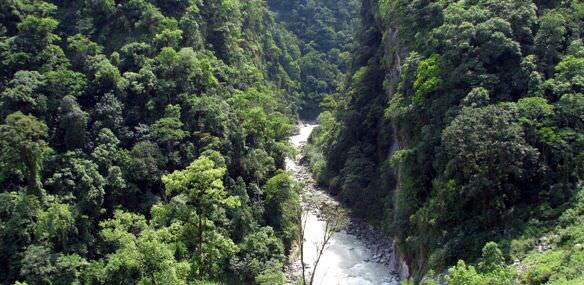

Affected Citizens of Teesta (ACT) - Dzongu
IMPACT ON SANCTITY OF THE REGION WITH SPECIAL REFERENCE TO DZONGU
The local populace, irrespective of their religious affiliation, are also nature worshippers due to which the trees, plants, mountains, streams and rocks are considered sacred. Infact the EIA report also acknowledges this on page 5 - 17. However, later in the report (page 5 - 23) it is mentioned that "no monuments of cultural/ religious/historical/archaeological importance is reported in the project as well as the study area". This is not true because the entire natural landscape is considered sacred by the people as mentioned before. For example, the Leydo or holy stone at Chungthang along with the only paddy field here is considered to be blessed by non other than the patron saint of Sikkim, Guru Padmasambhava in the 8th century, while he was on his way to Tibet. The stone has a footprint of the Guru and a perennial source of holy water. Another example is that of the Tamring Ney located little below Theng village which the Lepchas believe is a sacred tunnel connecting Theng with Ney Go above Shipgyer village.
There are a number of other such sites of religious significance in the study area which a proper study would have highlighted. It is a matter of great concern that these do not find any mention in the EIA report.
As has been experienced in Sikkim earlier, with the coming in of a large number of people of diverse religions for mega projects, there is a sudden increase in the places of worship which has an impact on the existing cultural and religious landscape and practices.
DZONGU THE SACRED LAND OF THE LEPCHA
Dzongu, which in Tibetan means the head of the Dzongs or head of the District, is a region in North District of Sikkim State. Majority of the inhabitants are the authochtons of the region or the Lepcha. The Lepcha community believe the almighty creator "id Bu dey rum" created the first human being there and thereafter the Lepcha spread to all other places. The Lepcha being natural worshippers and shamanists believe that the soul does not die but by the powers of the Muns (female priest) are all relocated in the hills, dales and the mountain in this region below the mighty Khangchendzonga.
The Tolung Monastery houses some of the largest and most priceless relics and treasures dating back to the 8th century.
The Zee Tsachu below the remote Sakyong and Pentong villages is one of the most sacred officially notified hot springs. This will be more or less submerged by the Panan Hydro Project.
Above Tolung Monastery lies the sacred Kishong lake which is in the shape of Guru Rimpoche's hat. The lake is split in between by weed resembling rice plants in that altitude.

Source: SIBLAC
POLITICAL IMPACT ON THE LEPCHAS AND DZONGU IN PARTICULAR
The Dzongu Assembly constituency is a reserved constituency which, technically, only a Lepcha could represent. However, the new organization/delimitation of the assembly constituencies and the possible setting up of labour camps and staff colonies of the power projects around Mangan, Thingchim and Mangshila will not only enable a non-Lepcha to contest in that constituency. The infusion of more non-Lepcha voters might eventually result in a non-Lepcha representation of the constituency thereby depriving the autochthons of the state from ever having a political voice in their own land.


| SATYAGRAHA |
Warriors for a Cause
"I will die but won't allow the mega power projects in Dzongu" - Dawa Lepcha.
Two Lepcha youths from Dzongu rocked the state of Sikkim and the world with their selfless stand against the hydro projects. Dawa T. Lepcha and Tenzing Lepcha went on hunger strike in the spirit of Gandhian Satyagraha from June 22, 2007 to September 27, 2009.
Chronicles of the campaign - and more - at
| TEESTA |
Will the Teesta river survive? In order to construct one kilometer of tunnel, approximately 150 tons of dynamite are required. Imagine how much blasting will be done for 30 power projects! Seventy percent of the river to flow underground!
| DZONGU |
Dzongu in North Sikkim is the holy place for Lepchas spread all over the world. Process has begun for seven mega power projects spanning the length and breadth of this protected area.
| ENVIRONMENT |
Environment Impact Assessment (EIA)
Blatant violations of procedural and environmental norms. Get the distressing facts at our EIA-page.
| TEESTA STAGE V |
Much went wrong during design, assessment and construction of Teesta Stage V HEP. For a truly sustainable and adapted development, a different approach is required.
| VIOLATIONS |
Environment Protection Act (EPA) as well as Forest Conservation Act (FCA) were repeatedly violated by the companies involved. A non-exhaustive listing for Teesta Stage V only (NHPC).
| DOCUMENTS |
• Statements, appeals and proceedings by ACT
• Scientific papers substantiating ACT's concerns
• Press reports covering disproportionate projects in Sikkim and ACT's struggle for protection
| MEDIA |
• Photo-Galleries
• Collection of Documentaries
© Affected Citizens of Teesta 2007 - 2023
NGOs supporting ACT: Concerned Lepchas of Sikkim (CLOS) - Sangha of Dzongu (SOD) - Citizens Forum of Sikkim (CFS) - Sikkimese Association for Environment
While all the organizations supporting ACT share the common goal of protecting the environment, individual groups can, and sometimes do, differ in their approaches to specific issues highlighted above. The stand taken by ACT does not necessarily includes of everybody in Sikkim and other parts. If anyone wishes to differ, they are welcomed to put forward their views, comments and disagreements to info@actsikkim.com. Everybody is welcome!